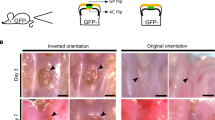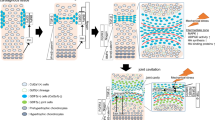Summary
The prenatal and postnatal development of the mouse knee joint was investigated by transmission and scanning electron microscopy. In the prenatal stage, following the appearance of a narrow intercellular cleft between two skeletal elements on the 16th fetal day, clefting extended into the lateral synovial mesenchyme. In some regions, the extension of the cleft was very rapid, but in a certain region (future fat pad region), it was somewhat slower. Macrophage-like cells appeared in the synovial mesenchyme on the 16th fetal day, and then increased in number, and were distributed as if they were clustering around the presumptive clefting zone in the future fat pad region on the 17th–18th fetal day. This suggests that macrophage-like cells may participate in joint development, as they phagocytize and remove some kinds of solid extracellular matrix, and facilitate the cleft extension. In the early postnatal stage, scanning electron microscopic observations showed that there were two different types of cell in the synovial lining. One of them exhibited a surface morphology corresponding to that of macrophages: a spherical cell body and numerous pseudopodia. The other type of cell exhibited various cell shapes with many cytoplasmic processes extending along the synovial surface.
Similar content being viewed by others
References
Barland P, Novikoff AB, Hamerman D (1962) Electron microscopy of the human synovial membrane. J Cell Biol 14:207–220
Cameron HU, MacNab I (1973) Scanning electron microscopic studies of the hip joint capsule and synovial membrane. Can J Surg 16:388–392
Date K (1979) Scanning electron microscope studies on the synovial membrane. Arch Histol Jpn 42:517–531
Edwards JCW (1982) The origin of type A synovial lining cells. Immunobiology 161:227–231
Edwards JCW, Willoughby DA (1982) Demonstration of bone marrow derived cells in synovial lining by means of giant intracellular granules as genetic markers. Ann Rheum Dis 41:177–182
Edwards JCW, Sedgwick AD, Willoughby DA (1981) The formation of a structure with features of synovial lining by subcutaneous injection of air: an in vivo tissue culture system. J Pathol 134:147–156
Edwards JCW, Sedgwick AD, Willoughby DA (1982) Membrane properties and esterase activity of synovial lining cells: further evidence for a mononuclear phagocyte subpopulation. Ann Rheum Dis 41:282–286
Elliott S, Cooke TDV (1986) Scanning electron microscopy of antigen-induced arthritic joints. I. Inflammatory cell interactions at synovial-meniscal surfaces during the arthus response. J Rheumatol 13:401–407
Fell HB, Glauert AM, Barratt MEJ, Green R (1976) The pig synovium. I. The intact synovium in vivo and organ culture. J Anat 122:663–680
Fujita T, Inoue H, Kodama T (1968) Scanning electron microscopy of the normal and rheumatoid synovial membranes. Arch Histol Jpn 29:511–522
Ghadially FN (1983) Fine structure of synovial joints. Butterworth, London
Graabæk PM (1982) Ultrastructural evidence for two distinct types of synoviocytes in rat synovial membrane. J Ultrastruct Res 78:321–339
Graabæk PM (1984) Characteristics of the two types of synoviocytes in rat synovial membrane: an ultrastructural study. Lab Invest 50:690–702
Hogg N, Palmer CG, Revell PA (1985) Mononuclear phagocytes of normal and rheumatoid synovial membrane identified by monoclonal antibodies. Immunology 56:673–681
Inoue T, Osatake H (1988) A new drying method of biological specimens for scanning electron microscopy: the t-butyl alcohol freeze-drying method. Arch Histol Cytol 51:53–59
Krey PR, Cohen AS, Smith CB, Finland M (1971) The human fetal synovium: histology, fine structure and changes in organ culture. Arthritis Rheum 14:319–341
Leach DH, Caldwell SJ, Ferguson JG (1988) Ultrastructural study of synovial membrane from the antebrachiocarpal joint of calves. Acta Anat 133:234–246
Link G, Porte A (1978) B-cells of the synovial membrane. II. Differentiation during development of the synovial cavity in the mouse. Cell Tissue Res 195:251–265
Llusa-Perez M, Suso-Vergara S, Ruano-Gil D (1988) Recording of chick embryo movements and their correlation with joint development. Acta Anat 132:55–58
Mapp PI, Revell PA (1988) Ultrastructural characterisation of macrophages (type A cells) in the synovial lining. Rheumatol Int 8:171–176
McDonald IN, Levick IR (1988) Morphology of surface synoviocytes in situ at normal and raised joint pressure, studied by scanning electron microscopy. Ann Rheum Dis 47:232–240
Mitrovic DR (1977) Development of metatarsophalangeal joint of the chick embryo: morphological, ultrastructural and histochemical studies. Am J Anat 150:333–348
Mitrovic D (1982) Development of the articular cavity in paralyzed chick embryos and in chick embryo limb buds cultured on chorioallantoic membranes. Acta Anat 113:313–324
Okada Y, Nakanishi I, Kajikawa K (1981) Ultrastructure of the mouse synovial membrane. Development and organization of the extracellular matrix. Arthritis Rheum 24:835–843
Palmer DG, Selvendran Y, Allen C, Revell PA, Hogg N (1985) Features of synovial membrane identified with monoclonal antibodies. Clin Exp Immunol 59:529–538
Revell PA (1989) Synovial lining cells. Rheumatol Int 9:49–51
Ruano-Gil D, Nardi-Vilardaga J, Teixidor-Johe A (1985) Embryonal hypermobility and articular development. Acta Anat 123:90–92
Shively JA, Van Sickle DC (1977) Scanning electron microscopy of equine synovial membrane. Am J Vet Res 38:681–684
Sledge CB (1989) Biology of the joint. In: Kelley WN, Harris ED, Ruddy S, Sledge CB (eds) Textbook of rheumatology, 3rd edn. Saunders, Philadelphia, pp 1–21
Van Furth R (1982) Current view on the mononuclear phagocyte system. Immunobiology 161:178–185
Wysocki GP, Brinkhous KM, Hill C (1972) Scanning electron microscopy of synovial membrane. Arch Pathol 93:172–177
Author information
Authors and Affiliations
Rights and permissions
About this article
Cite this article
Takabatake, K., Yamamoto, T. Morphology of the synovium during its differentiation and development in the mouse knee joint. Anat Embryol 183, 537–544 (1991). https://doi.org/10.1007/BF00187902
Accepted:
Issue Date:
DOI: https://doi.org/10.1007/BF00187902




